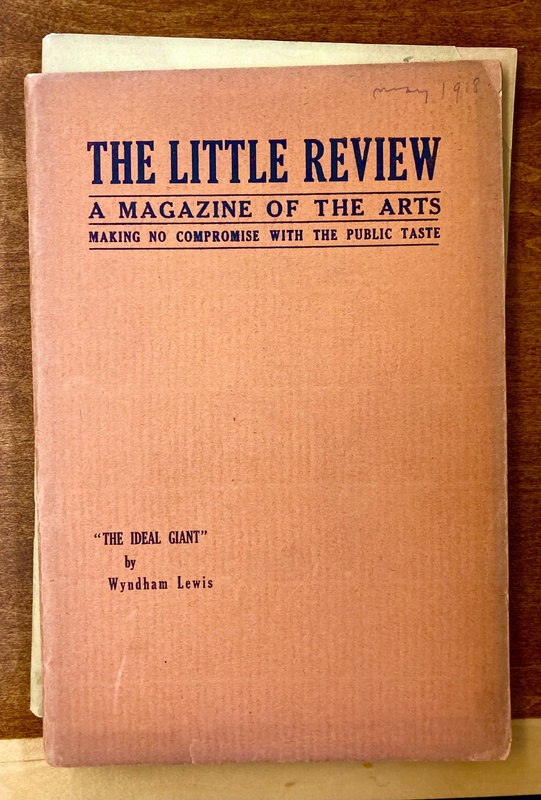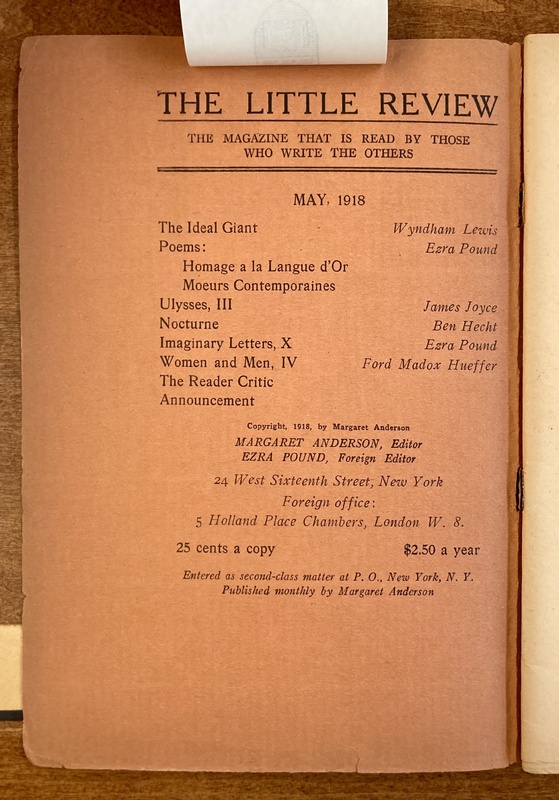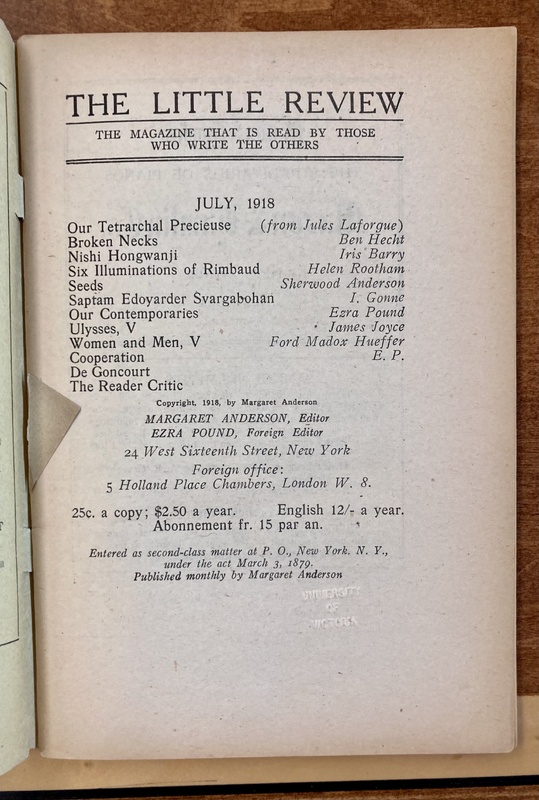Holmes, Josie (Little Magazine)
Rationale: The Little Review
For my final project I have decided to look at two copies of The Little Review magazine. In particular the May, 1918 edition and the July, 1918 edition. These literary magazines are one of the sources where Ulysses was released chapter by chapter through the different editions of the magazine. They also contain quite a few other written pieces that I believe influence the reader's understanding of Ulysses.
I have chosen these copies because they contain Chapter III, “Proteus”, and Chapter V, “Lotus Eaters” respectively. These chapters have very different styles of writing so, through my project I will be looking at the written material surrounding the chapters to see if those materials are reflective of the writing style in Ulysses. Before I had closely looked at the magazines, I had guessed that there would be poetry before Chapter III and prose before Chapter V and upon looking at the magazines I found that I was correct. I would like to further discuss why this choice was made and how it affects the reader’s understanding of Ulysses. Does reading poetry before Chapter III cause the reader to view it as a free verse poem? Would the reader view the chapter differently if they had been reading a prose essay beforehand? Similarly, I would like to further research how the prose reading before Chapter V affects the readers. That chapter also contains long, lilting passages that are similar to Chapter III, but we read it in a very different way. Because of its clearer narrative structure we are able to understand it as a story that moves along through the pages, rather than a rambling stream of consciousness. But what if the reader had been exposed to nothing but poetry before reading it? Is it possible to read Chapter V as a sort of poem as well? This is what I will be further discussing in my project.
Additionally, I would like to consider the method of release they used and how that may have contributed to its popularity. Ulysses is quite a difficult read so it is interesting to think about how it became so widely read. I think it’s popularity is in part due to how they released it chapter by chapter. Although the chapter by chapter release was mostly due to Joyce being in the process of writing the book, I think that this style of release in the magazine was a very interesting marketing strategy. By releasing it in chapters they would be able to drum up interest in between release dates. That, along with the taboo nature of the book, caused it to become frequently read because of course, what better way to get people to do something then by telling them not to do it. I also believe that releasing it chapter by chapter may have made it less of a daunting task to read and would keep the reader’s interest for a longer sustained amount of time. I think that the ability to only access a part of the book at a time would have drawn readers interest and caused them to be more invested in the book. It is all of these ideas that I will continue to research and develop over the course of my project.
Literary Review
By placing poetry in front of “Proteus”, I believe that the reader is inclined to read it as an open form poem instead of a regular narrative prose book. This is because the reader is already in the poetic mindset after reading the surrounding material. This is similar to how “Lotus Eaters” is contextualised. The material that comes before “Lotus Eaters” is significantly more academic and leads to a more straightforward understanding of the text, despite it not having an entirely straightforward narrative form.
The first source I have chosen is “The Magazine Context for The Little Review “Ulysses” ”. The paper discusses the other written pieces chosen to surround the chapters of Ulysses published in The Little Review. It talks about how “we get a sense of the network of authors in the Little Review in which Joyce was a member by virtue of having his work published alongside theirs” (Scholes, 383). This topic is relevant to my research as it contextualises the works published alongside Ulysses. The way that Joyce’s work was published alongside already well established authors such as Ezra Pound would cause people to think highly of his work before even reading it. By association, Joyce was put on a bit of a pedestal and his work was viewed highly by the people reading it. In this way the surrounding literature affects the reader’s understanding of the work being quality literature that should be well praised and read by many.
My next source is “Re/Joycean Mistakes, Misprisions, and Modernist Contexts”. In part, this article discusses the stylistic elements of the chapters. This is important to my research as it talks about how the reader is supposed to interpret the chapters and gives more insight into why the stylistic choices were made. The rest of the article discusses the context of the novel in comparison with other modernist writers, which is not as relevant to my paper but interesting nonetheless. Ulysses contains many interesting, and at times confusing, stylistic choices. This paper attempts to make sense of them by putting them into clear literary terms. I find this to be an interesting choice to try and clearly label Joyce’s choices as one exact thing or another. In my opinion there is so much crossover between Joyce’s narrative voices and stylistic choices that it seems nearly impossible to label them as exactly one style. One could claim that “Proteus” could only be read as a prose narrative because it is part of an entire prose novel whereas I read it as poetry. I believe that each section can be read in many different ways and can be classified as multiple different styles of writing. To try and label it as one particular thing is far too confining.
The third article I have chosen is “Livid Time: Time, Tenses, and Temporal Deixis in Ulysses”. This article talks about the importance of narrative tenses and the “complex narrative dynamics reaching for the very foundation of the subject's experience of time and the way such experience can be linguistically and narratively conveyed” (Prudente, 3). The concept of time in the novel is presented in very different ways. That can especially be seen in the contrast of “Proteus” and “Lotus Eaters”. By discussing the different ways time is presented in the book this article enriches our understanding of how each chapter should be interpreted.
I then looked at “The Reading of Ulysses”. This article states that Ulysses is “organized as a poem rather than as a naturalistic novel” (Knight, 64). I think this is an interesting statement to make as I don’t think the entire book can be characterised as a poem. There are definite sections, such as the “Proteus” chapter, that can easily be read as a poem but I don’t believe that the entire novel can be categorized as such. This article was interesting to read in relation to my project as half the time I agreed with their statements and the other half I disagreed.
My final source is “A Bloom Without a Flower, or How to Read Lotus Eaters’ ”. This source discusses how to properly analyze “Lotus Eaters” by examining the language of the flowers. This is relevant to my research as it provides more insight into our understanding of “Lotus Eaters”. Since the chapter is a relatively easier read, at least in comparison with “Proteus”, it was very influential in getting a deeper understanding of “Lotus Eaters” instead of reading it on a surface level. These sources provide new ways to look at the chapters “Proteus” and “Lotus Eaters” and they give us further insight into the novel.
Narrative and Stylistic Differences in Ulysses
“Proteus” and “Lotus Eaters” have very different narrative styles. “Proteus” has a much more lyrical and difficult to follow narrative voice, it bounces through time and hypotheticals with almost no explanation. This style is opposed in “Lotus Eaters” where everything follows a more clearly laid out storyline and is given more explanation. These choices in narrative style are mimicked in the contents of The Little Review magazine that come before each chapter individually. These stylistic choices impact the reader's understanding of the book and cause us to interpret them as different types of writing.
The chapter “Proteus” gives the reader the impression that the book could be read as an open form poem. One of the stylistic choices that gives us this idea is Joyce’s use of alliteration. He chooses words to use in sentences together such as “cathedral close”, “mane … moon” “houyhnhnm, horsenostrilled” and “garland of grey” (Joyce, 33). As well as some slant rhymes that wouldn’t be noticed unless spoken aloud such as “oval equine” (33). These almost rhymes and lyrical sentences give the reader the impression that this is not a normal prose piece of writing and instead might be a poem as most prose writing is not usually that melodic. Another way Joyce emphasized the chapter's poetic nature is through direct, incomplete sentences. One example of this is “down, up, forward, back” (33). This is not a proper sentence as it does not include a subject. The reader cannot be positive about what Joyce is describing when he says “down, up, forward, back”. We could assume that he is describing the church bells ringing in the background but it is never said outright. There is so much room for interpretation within this chapter which makes it easily readable as a poem. Things are left open and unanswered, not many things are completely lined out for the reader so we have to guess and interpret what Joyce is trying to convey, similarly to how one might try and find meaning in a poem.
In The Little Review, “Proteus” is preceded by two poems by Ezra Pound: Homage a la Langue d’Or and Moeurs Contemporaines. These poems are each written with their own distinctive style but they both use stylistic choices similar to the ones made in “Proteus”. In Moeurs Contemporaines, each thought is given a line. The storyline of this poem, on surface level, is much easier to understand than in Proteus but it sets your mind up for reading a work that flows from line to line. One passage that stood out was “it is an officer, and a gentleman, and an architect” (Pound, 28). This line has a similar structure to “down, up, forward, back” in “Proteus”. In both passages you can guess at what they’re talking about but it is not explicitly explained. By placing Pound’s work in front of Joyce’s the reader is inexplicitly told that Joyce’s work is of the same calibre as Pound’s. His work as a well loved author prefaces Joyce’s and forces the reader to consider it in the same light and frame of mind.
Although there are still some un-prose-like stylistic features in “Lotus Eaters” such as one word sentences like “tea”, these one word sentences are still part of the fully formed thoughts that surround them (Joyce, 58). In “Lotus Eaters”, things are better explained than in “Proteus” and the reader is actually able to follow the plotline without too much difficulty. Even the paragraph spacing seems more purposeful in “Lotus Eaters”. In “Proteus” there are a lot of seemingly random changes in paragraphs such as between speakers, in bits of song and through flashbacks. The change in paragraph structure increases its poetic nature, whereas in “Lotus Eaters” there are far fewer changes like that.
One of the pieces that comes before “Lotus Eaters” in The Little Review is Our Contemporaries by Ezra Pound. This piece is a good indicator of change in narrative voice. It is also far more straightforward than Pound’s writing that came before “Proteus”. The paragraph style mimics the one used in “Lotus Eaters” and solidifies the reader's understanding of this being a strictly prose piece. Both chapters of the Ulysses within The Little Review show how the context given to literature makes a difference in how we interpret it.
Ulysses can be interpreted in many different ways. In my opinion it is nearly impossible to classify it in any one particular way. It is only through context and premeditated thought that we are able to classify it as a specific type of writing.
Bibliography
Anderson, Margaret C., et al. “Ulysses, III”, “Homage a la Langue d’Or” and “Moeurs Contemporaines.” The Little Review, Published by Margaret Anderson, New York, 1918.
Anderson, Margaret C., et al. “Ulysses, V”, “Our Contemporaries.” The Little Review, Published by Margaret Anderson, New York, 1918.
Finn, Anna M. “A Bloom without a Flower, or How to Read ‘Lotus Eaters.’” James Joyce Quarterly, vol. 52, no. 3-4, 2015, pp. 623–635., https://doi.org/10.1353/jjq.2015.0032.
Henke, Suzette. “Re/Joycean Mistakes, Misprisions, and Modernist Contexts.” ESC: English Studies in Canada, vol. 30, no. 3, 2004, pp. 175–188., https://doi.org/10.1353/esc.2004.0042.
Joyce, James, et al. Ulysses. Vintage, 2022.
Joyce, James, et al. “The Magazine Context for The Little Review ‘Ulysses.’” The Little Review "Ulysses", Yale University Press, New Haven, 2015, pp. 381–425.
Knight, Douglas. “The Reading of Ulysses.” ELH, vol. 19, no. 1, 1952, p. 64., https://doi.org/10.2307/2871872.
Prudente, Teresa. “Livid Time: Time, Tenses, and Temporal Deixis in Ulysses.” Journal of Narrative Theory, vol. 48, no. 1, 2018, pp. 1–28., https://doi.org/10.1353/jnt.2018.0000.



